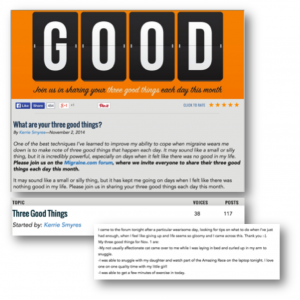We know that the formation of healthy lifestyle habits is critical to overall health. However, adherence to exercise programs, medication regimens, or dietary changes can be challenging. So how do we help patients develop habits to improve their overall health?
Habits are defined actions employed without conscious thought.1 Habit forming potential of any behavior is often driven by two factors: frequency and perceived utility. The more frequently a new behavior occurs, especially within a short period of time, the stronger the habit becomes. Likewise, the more rewarding the behavior is perceived to be (its utility), the greater the chance for habit formation. The “Hook Model” is one method that we use at Health Union to build value and encourage habit-forming behaviors within our communities. Four key components converge in the hook model – a trigger, an action, a reward, and an investment2 – to create ecosystems that cultivate engagement habits and motivate people to live better with their health conditions.
Triggers
Health Union communities use both internal and external triggers to encourage patient engagement. External triggers may include advertisements or comments from doctors, family, and friends; while internal triggers are leveraged when an action becomes strongly tied to a thought, emotion or preexisting routine, like checking email every morning. While we utilize some paid external triggers, like Facebook advertising, we’ve found that relationship triggers (social media sharing/word of mouth) and owned triggers (opting into a weekly newsletter) are most effective for long-term engagement. Owned triggers are most likely to prompt repeat engagement until a habit is formed, and relationship triggers support continuous community growth.
Action
 The more people interact with your product, the more likely they are to keep doing it. Our community engagement strategy creates a “funnel” approach to increase the level of participation over time, knowing that simple actions can lead to big changes in future behavior.3 For instance, our members may start as site visitors, then progress to following us on social media and engage in passive activities like anonymous polls. Passive participation may lead to newsletter registration and eventually active engagement by posting comments or personal stories. It’s important to make it easy for even the most passive patients to engage while still providing outlets for the most active members.
The more people interact with your product, the more likely they are to keep doing it. Our community engagement strategy creates a “funnel” approach to increase the level of participation over time, knowing that simple actions can lead to big changes in future behavior.3 For instance, our members may start as site visitors, then progress to following us on social media and engage in passive activities like anonymous polls. Passive participation may lead to newsletter registration and eventually active engagement by posting comments or personal stories. It’s important to make it easy for even the most passive patients to engage while still providing outlets for the most active members.
Reward
Provide a real benefit to action – with variability – and do it quickly! Show people that taking action results in a clear benefit. Of course, keep in mind that the preferred benefits vary from one person to the next. Make sure to clearly communicate what the reward is – whether that is answers to basic questions, immediate poll results upon voting, published results from surveys, or community support. Don’t assume the reward is obvious and communicate the benefit gained by others as well as that of the individual. Variability can multiply the natural effects of a reward and keep people coming back for more. All Health Union communities provide daily content that is relevant and useful, but the type of content, topics, and authors are varied to create novelty.
Encourage people to make an investment, beyond just lurking or passively clicking. This may be an emotional investment, an investment of time, or a contribution of personal information. Investment implies action that will improve the service for the next visit. And, the greater the investment, the more likely they are to continue engaging over time, thereby increasing the value of the product. For example, the simplest investment is to follow one of our social media accounts. However, we also invite members to “own” part of the site by participating in surveys and publishing personal stories.
What else can we do?
In addition to the four elements of the Hook Model, don’t forget to …
- Remove barriers and provide support. Be aware of both perceived and actual barriers. For example, in response to a perceived barrier that weight loss is dependent on foregoing all desserts, provide recipes for healthier dessert options.
- Strengthen self-efficacy, the belief in one’s own ability to complete tasks and reach goals. Since many people are uncomfortable asking their doctors questions, provide discussion guides to encourage dialogue focusing on areas where the patient is the expert – like how a condition affects day-to-day life.
- Find what people are doing already, and make it easier for them by linking habits to daily routines.4 Our content strategy focuses heavily on giving people the information we know they are seeking, where they are already seeking it (with social media and search).
The ultimate goal is to create a cycle of interaction where the investment itself becomes an internal trigger. Members seek responses to topics discussed within the community – that desire for shared experience is the trigger to continue engaging. And then, they’re hooked!
References:
- E. Morsella, J.A. Bargh, P.M. Gollwitzer, eds., Oxford Handbook of Human Action (New York: Oxford University Press, 2008).
- Eyal, Nir. Hooked: How to Build Habit-Forming Products.
- J.L. Freedman and S.C. Fraser, “Compliance Without Pressure: The Foot-in-the-door Technique.” Journal of Personality and Social Psychology 4, no. 2 (1966) 196-202.
- Bas Verplanken and Wendy Wood, “Interventions to Break and Create Consumer Habits, Journal of Public Policy & Marketing 25, no. 1 (March 2006): 90-103, doi: 10.1509/jppm.25.1.90.


Comments are closed.